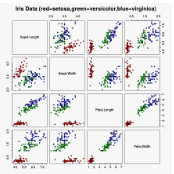Iris recognition of living individuals is a mature biometric modality that has been adopted globally from governmental ID programs, border crossing, voter registration and de-duplication, to unlocking mobile phones. On the other hand, the possibility of recognizing deceased subjects with their iris patterns has emerged recently. In this paper, we present an end-to-end deep learning-based method for postmortem iris segmentation and recognition with a special visualization technique intended to support forensic human examiners in their efforts. The proposed postmortem iris segmentation approach outperforms the state of the art and in addition to iris annulus, as in case of classical iris segmentation methods - detects abnormal regions caused by eye decomposition processes, such as furrows or irregular specular highlights present on the drying and wrinkling cornea. The method was trained and validated with data acquired from 171 cadavers, kept in mortuary conditions, and tested on subject-disjoint data acquired from 259 deceased subjects. To our knowledge, this is the largest corpus of data used in postmortem iris recognition research to date. The source code of the proposed method are offered with the paper. The test data will be available through the National Archive of Criminal Justice Data (NACJD) archives.
翻译:从政府身份证方案、边界过境、选民登记和免重复到解开移动电话,对活人的认识是一种成熟的生物鉴别方式,从政府身份证方案、边界过境、选民登记和免重复到解开移动电话,在全球普遍采用。另一方面,最近出现了承认死者身份及其虹膜模式的可能性。在本文件中,我们提出了一个基于深到底深深学习的尸检皮肤分解和识别方法,该方法以特殊视觉化技术支持法医人类检查人员的工作。提议的尸检分解方法超越了最新水平,并且与Iris 废止法相比,如古典的虹膜分解法方法----检测了眼分解过程造成的异常区域,如毛草或眼分解过程造成的异常区域,如干燥和皱纹玉米上的异常光谱。该方法经过培训和验证,使用了从171个尸体采集的数据,保存在丧葬条件中,并测试了从259个死者身上获得的主题分解数据。据我们所知,这是尸检后识别研究中使用的最大数据集。拟议方法的刑事源代码将通过国家档案馆提供数据。




